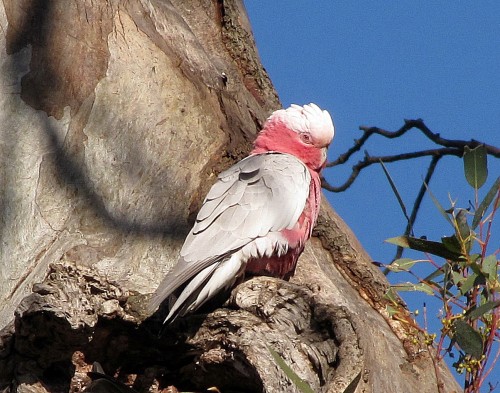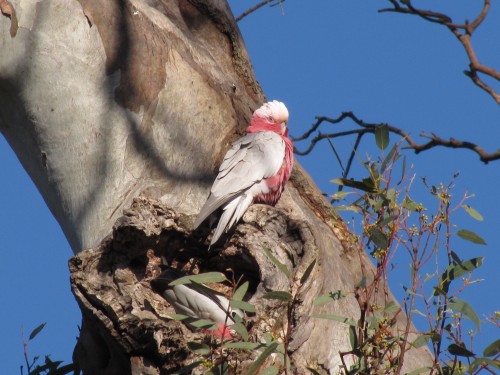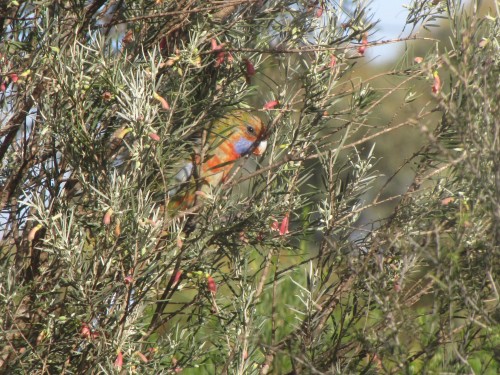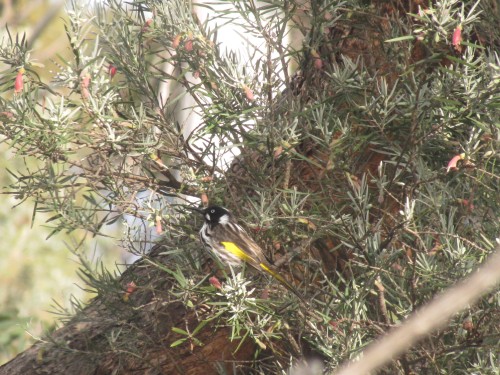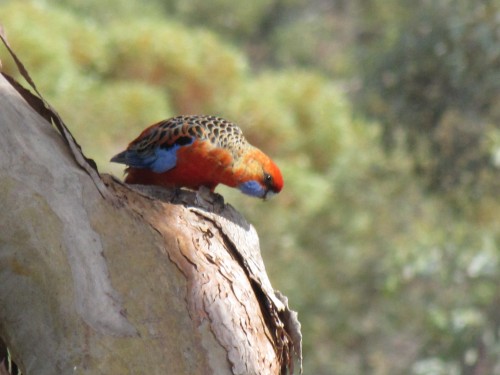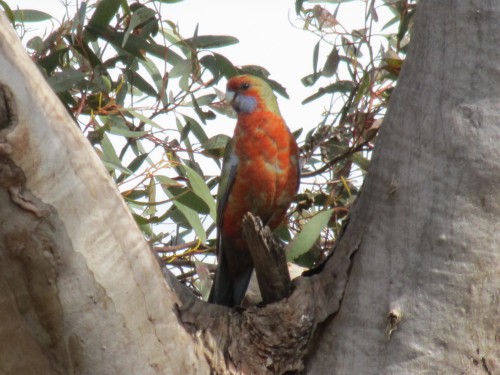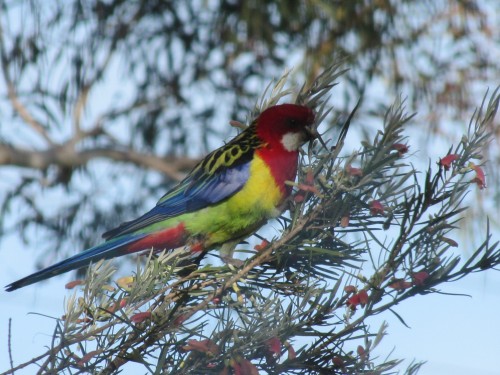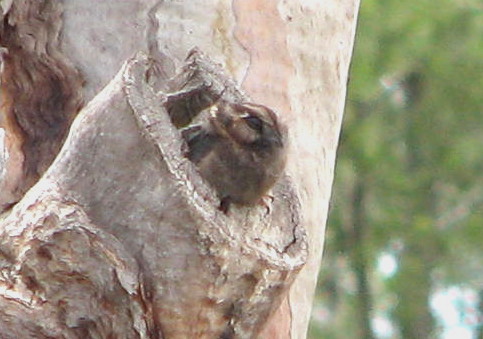Feeding Adelaide Rosellas
Last weekend we were having breakfast in our sun-room when four Adelaide Rosellas flew into one of the bushes in our garden, an Eremophila youngii (see photo above). I had the camera ready for many minutes but they would not come out into full sunlight and the above photo is the best I captured on this occasion. Just one bird is seen peeking out to see what was happening around it. The others were hidden in the foliage, busy feeding on the nectar in the flowers.
The Adelaide Rosella is now a frequent visitor to our garden. It is a race of the widespread Crimson Rosella and confined to the Adelaide region, Mt Lofty Ranges and mid-north of South Australia. Its occurrence here in Murray Bridge is a relatively recent extension of that range.
Parrots occurring in our garden in Murray Bridge include:
- Adelaide Rosella (regular visitor, possibly breeding)
- Crimson Rosella (occasional)
- Eastern Rosella (regular)
- Mallee Ringneck (resident breeding)
- Galah (resident breeding)
- Rainbow Lorikeet (regular)
- Purple-crowned Lorikeet (regular)
- Musk Lorikeet (occasional)
- Budgerigar (rare)
- Sulphur-crested Cockatoo (rare)
- Little Corella (occasional)
- Yellow-tailed Black-cockatoo (once only)
- Cockatiel (occasional)
- Red-rumped Parrot (occasional)
Over the years we have lived here we have planted many native Australian plants, not only for their attractiveness when they flower, but also to attract our native wildlife, especially the birds. We have quite a few eremophilas, grevilleas and correas as well as many others. The particular bush shown in the photo has flowers on it for much of the year so the rosellas and honeyeaters head for it on a daily basis. Below is another photo of the same bush, this time with a New Holland Honeyeater having a feed.
Further reading:
- Get out of my patch
- Red wattlebird in Eremophila bush
- Mallee Native Plants Nursery – my wife’s site about Australian plants
Rosellas come to visit
This morning while we were having breakfast a small flock of four Adelaide Rosellas came to visit our garden. It was delightful to see them feeding on some of the flowers of our native plants such as eremophilas. This sighting is notable in so much as they are uncommon visitors to our garden here on the outskirts of Murray Bridge, some 80km south east of Adelaide, South Australia.
Adelaide Rosellas are a sub-species of the widespread Crimson Rosella, a common species in southern and eastern Australia. The Adelaide Rosella is largely confined to the Adelaide region through to the mid-north districts of the state. Until recent years I have not observed this sub-species so far east of the Mt Lofty Ranges, and they seem to be extending their range eastwards. We are now seeing them every few months in our garden.
Further reading:
A small birding accident
This morning I had a small birding accident. I didn’t hurt myself – or anyone or anything else. This week the forecast is for severe hot weather after a prolonged period of mild weather, so I decided before breakfast that our bird baths should be replenished every morning. The resident birds sure appreciate the fresh water every day.
I filled a handy bucket from the rainwater tap – I prefer to treat them to rainwater rather than tap water – and trundled outside into the garden. As I carried the very full bucket of water I stepped off the veranda and… disaster! The cheap plastic bucket shattered into about a dozen pieces and water splashed all over my shoes, socks, and legs. The bucket – what was left of it – was immediately thrown in the rubbish bin and another one fetched and filled from the tap over the laundry tub. This time the water reached its destination without further incident.
My efforts were rewarded about an hour later. While reading the paper at the table in our sun room two birds flew in to have a drink and a bath. One was a Mallee Ringneck and the other an Eastern Rosella (see photo above) Strangely, these two birds have been seen together in our garden on many occasions over the last few years. Eastern rosellas are not common in this area.
Further reading:
A little night time visitor
Last night we were watching television with the lounge door open; it was a pleasant summer’s night. During a particularly quiet segment of the show we were watching we suddenly heard the churring call of our “resident” Australian Owlet-nightjar.
“He’s still around,’ we both cried out.
Now I need to clarify a few points here:
- I use the word “our” loosely. It is a wild bird in the natural environment so we do not own it.
- I am not sure if this particular bird is actually a resident on our 5 acre property. We do hear it often enough to think that it is here most days, but have no proof of that.
- I have no idea if it is a male or female – to call it “he” is more of a generic term.
Over recent months we have not heard this bird calling many times at all, so it was delightful to hear the call last night. I like to think that it is quite contented living around here most of the time.
A few years ago one bird – perhaps the same one – took up occupation of a significant hollow in one of our mallee trees in our back yard. Amusingly, during the cool winter months it would emerge from the hollow every morning around 11am and sun itself in the opening of the hollow, call a few times and then retreat to sleep until evening. Sometimes we would even hear it calling again as it went out feeding during the night., being mostly a nocturnal species. It was on one of those occasions that I was able to sneak up closer for a photo (shown above).
Over the last two summers the hollow has come under the “ownership” of a pair of Mallee Ringneck parrots who have successfully added to their family each time. Lately they have been busy feeding two very persistent young ones which have recently fledged.
Further reading:
- Australian Owlet-nightjar
- Australian Owlet-nightjar
- Australian Owlet-nightjar does exist
- Australian Owlet-nightjar in our garden
- A special call in the night
